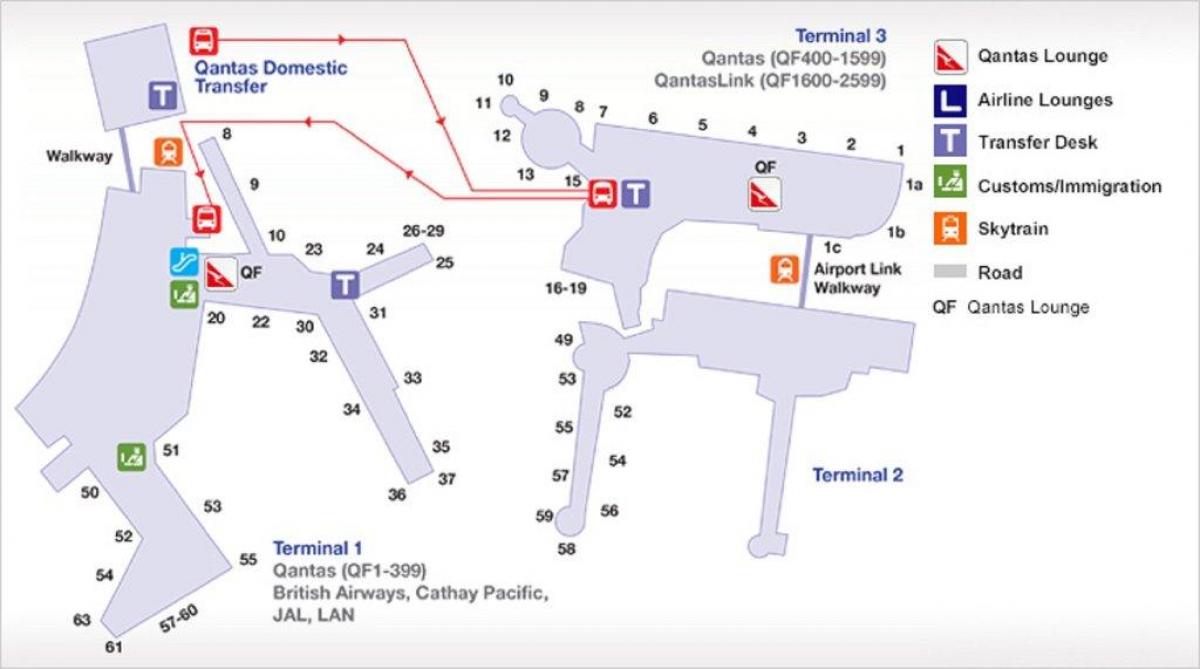search
Sydney airport map
Map of sydney airport. Sydney airport map (Australia) to print. Sydney airport map (Australia) to download. Sydney (Kingsford Smith) Airport (also known as Kingsford-Smith Airport and Sydney Airport) (IATA: SYD, ICAO: YSSY) (ASX: SYD) is located in the suburb of Mascot in Sydney, Australia as you can see in sydney airport map. It is the only major airport serving Sydney, and is a primary hub for Qantas, as well as a secondary hub for Virgin Australia and Jetstar Airways. Situated next to Botany Bay, the airport has three runways, colloquially known as the "east–west", "north–south" and "third" runways. Sydney Airport is one of the oldest continually operated airports in the world, and the busiest airport in Australia, handling 36 million passengers in 2010 and 289,741 aircraft movements in 2009. It was the 27th busiest airport in the world in 2010. The airport is managed by Sydney Airport Corporation Limited (SACL) and the current CEO is Kerrie Mather. Flights from Sydney link with all states and territories of Australia. Currently 47 domestic destinations are served to Sydney direct.
In 1933, the first gravel runways were built. Cooks River was diverted away from the area in 1947–52 to provide more land for the airport and other small streams were filled. When Mascot was declared an aerodrome in 1920 it was known as Sydney Airport, in 1953 it was renamed Sydney (Kingsford Smith) Airport in honour of Sir Charles Kingsford Smith, MC, AFC who was a pioneering Australian aviator (see sydney airport map). Up to the early sixties the majority of Sydney-siders referred to the airport as Mascot. The first paved runway was 07/25 and the next one constructed was 16/34 (now 16R/34L), jutting into Botany Bay, starting in 1959, to accommodate large jets. 07/25 is used mainly by lighter aircraft, although large four engine jet aircraft still periodically land on the runway from the east, when south-westerly winds are blowing in Sydney. 16R is presently the longest operational runway in Australia, with 14,300 ft (4,400 m) paved length and 12,850 ft (3,920 m) between the zebra thresholds.
Following completion, the "third runway" (as it is known to Sydneysiders) remained controversial because of increased aircraft movements, especially over many inner suburbs. The 1990s saw the formation of the No Aircraft Noise Party, although it failed to win a parliamentary seat in any of the elections it contested. There has been general acquiescence in the arrangements for Sydney Airport that were introduced by the Howard government shortly after its election, namely to maintain curfews between 11 pm and 6 am, rotate runway operation and fan flightpaths out, especially over water (especially Botany Bay) wherever possible and continue the use of noise abatement on aircraft on departure. In 1995 the Australian Government passed a law through parliament entitled "The Sydney Airport Curfew Act 1995" which limits the operating hours of the airport as its mentioned in sydney airport map.
In 2002, the Australian Government sold Sydney Airports Corporation Limited (later renamed to Sydney Airport Corporation Limited, SACL), the management authority for the airport, to Southern Cross Airports Corporation Holdings Ltd. 82.93 per cent of SACL is owned by MAp Airports International Limited, a subsidiary of Macquarie Bank, Sydney Airport Intervest GmbH own 12.11 per cent and Ontario Teachers Australia Trust own 4.96 per cent. SACL holds a 99 year lease on the airport which remains Crown land. In March 2010, the Australian Competition and Consumer Commission released a report sharply critical of price gouging at Sydney airport, ranking it fifth out of five airports as its shown in sydney airport map. The report noted Sydney Airport recorded the highest average prices at $13.63 per passenger, compared to the lowest of $7.96 at Melbourne Airport, while the price of short-term parking had almost doubled in the 2008–09 financial year, from $28 to $50 for four hours. The report also accused the airport of abusing its monopoly power.


